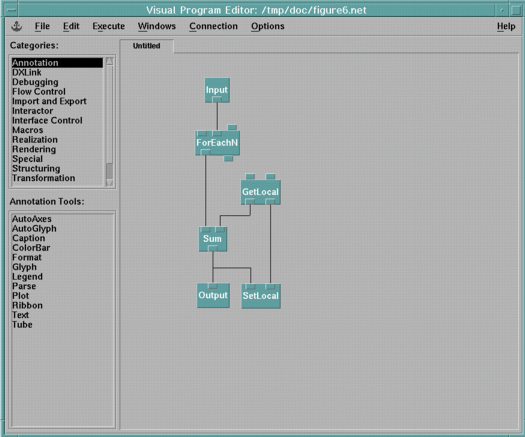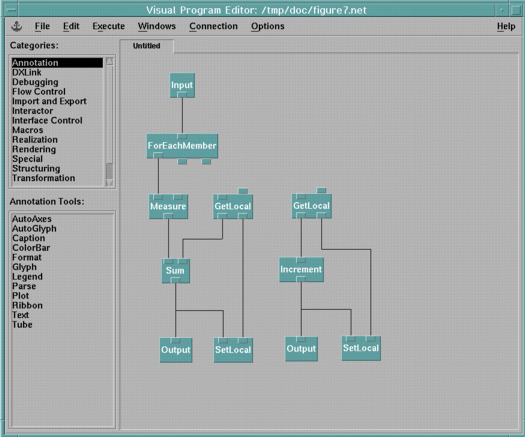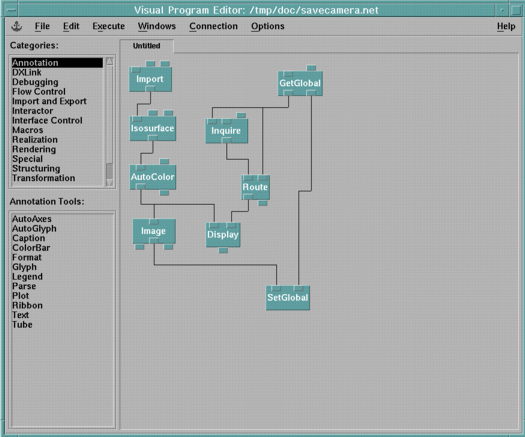

Some visualization applications require the retention of state from one execution to the next, which as discussed earlier, cannot be supported within the context of pure data flow. Consider, for example, the creation of a plot of data values at a given point while sequencing through a time series. The state of the plot from the prior execution is retrieved. It is updated by appending the new time-step information, and the result is then preserved by resaving the state of the plot for the next execution. Data Explorer provides two sets of tools for preserving state depending on whether the state needs to be preserved over one execution of the network or over multiple executions of the network. The tools for preserving state are GetLocal, SetLocal, GetGlobal, and SetGlobal. The Set tools enable you to save an object (in Data Explorer's cache) for access in a subsequent execution or iteration. The Get tools enable you to retrieve the object saved by the Set tools.
You pair a GetLocal and SetLocal in a visual program by creating an arc from GetLocal's link output parameter to SetLocal's link input parameter. In a visual program a GetLocal typically appears logically above a SetLocal. When GetLocal runs, it checks if an object has been saved in the cache. If no object was saved (as would be the case if SetLocal has not yet run) or the reset parameter to GetLocal is set, GetLocal outputs an initial value that you can set using the initial parameter. Otherwise, GetLocal retrieves the saved object from the cache and outputs it. When SetLocal runs, it saves its input object in the cache and then indicates that its paired GetLocal should simply be scheduled during the next iteration of a loop or the next time an execution is called for. (Note that if GetLocal is inside a macro, it will be executed only if the macro needs to be executed; that is, if the macro's inputs have changed or there is a side effect module in the macro.)
GetGlobal and SetGlobal are paired in the same way as GetLocal and SetLocal.
They also save and retrieve items from the cache. The main
difference is that GetGlobal and SetGlobal will preserve state over
more than one execution of a program. (However, recall that a complete
loop takes place within a single execution.)
Using GetGlobal and SetGlobal is comparable to using
a static variable in C-language programming. GetLocal and SetLocal are
good for saving state inside of a looping construct. Once the loop is
terminated, the state is reset for the next execution of the loop. To
save state in a program that uses a Sequencer module, you should
use GetGlobal and SetGlobal, since each iteration of the Sequencer
is a separate execution of the program as described in 4.5 , "Iteration using Looping".
Illustrated in Figure 22 is a simple macro that sums the numbers from 1 to N, where N is an input parameter. The start parameter to ForEachN has been set to 1. GetLocal and SetLocal are used to accumulate the sum. Sum is a trivial macro consisting of a Compute where the expression is "a+b." On the first iteration of the loop, GetLocal will output its initial value, which has been set to 0. On subsequent iterations GetLocal will output the accumulated value SetLocal saved during the previous iteration. When the loop terminates the final accumulated value is the output of the macro. This macro is roughly equivalent to the following C-language statements:
b = 0;
for (a=1; a<=10; a++)
b = b+a;
If the macro were run again, on the first iteration of the loop
GetLocal would again output its initial value.
(Note that the macro
will only run again if the input to the macro changes or the output of the
macro has been removed from cache.)
If you replaced the GetLocal and SetLocal in Figure 22
with
GetGlobal and SetGlobal it would be equivalent to the following
C-language statements:
int a;
static int b = 0;
for (a=1; a<=10; a++)
b = b+a;
While when SetLocal is used, the sum is reset each time the macro is
run, if SetGlobal is used, the sum of a previous execution is added to the
sum of the current execution. For example, let macro_local be the macro
shown in Figure 22 and macro_global be the same macro
but with
SetGlobal and GetGlobal substituted for SetLocal and GetLocal. If the
input to both macros is 10 then both macros will output 55 (the sum of numbers
1 to 10) the first time they are run. If an execution takes place
without the input to the macros changing then neither macro will run again
and the value 55 will be used as the output again. If you change the input
to 3 then macro_local will output 6 and macro_global will output 61 (55+6).
Illustrated in Figure 23 is a macro that returns the accumulated volumes of the members of a group and the number of members in the group. ForEachMember is used to iterate through the group. Measure is used to determine the volume of a member and the GetLocal and SetLocal pair on the left side of the macro is used to accumulate the volumes. For illustrative purposes, a loop containing GetLocal, SetLocal, and Increment is used to count the number of members in the group. (Inquire also provides this function, as does the index output of ForEachMember.) Increment is a trivial macro consisting of a Compute where the expression is set to "a+1." The initial values to both GetLocal tools are 0.

Illustrated in Figure 24 is a visual program that saves the current camera settings for use in the next execution of the program. The initial value of GetGlobal is NULL. The Inquire module checks to see that the output of GetGlobal is a valid camera object. If it's not a camera object, then Route is used to ensure that the Display module is not scheduled to run. When a new camera is chosen (for example by rotating the object in the Image window) the Display window will show the image using the previous execution's camera settings.

As mentioned previously, in a true data-flow implementation, all modules are pure functions (i.e. their outputs are fully defined by their inputs). Hence, processes are stateless with no side effects. A macro in Data Explorer is considered to be a function, with its outputs being fully defined by its inputs. This is no longer true when a GetGlobal module is added to a macro. GetLocal maintains state information only within one execution of the macro. GetGlobal maintains state information between executions, and therefore the outputs of a macro containing GetGlobal are no longer entirely defined by the inputs. The outputs from macros with state (containing a GetGlobal module) are guaranteed to stay in the cache until the inputs for that macro change. At that point, the results of the previous execution are discarded to make room for the new results. This is equivalent to setting the cache attribute of the macro to cache last for each of the outputs. These cache settings cannot be overwritten by the user. This guarantees coherency when executing macros with state.
[Data Explorer Home Page | Contact Data Explorer | Same document on Data Explorer Home Page ]